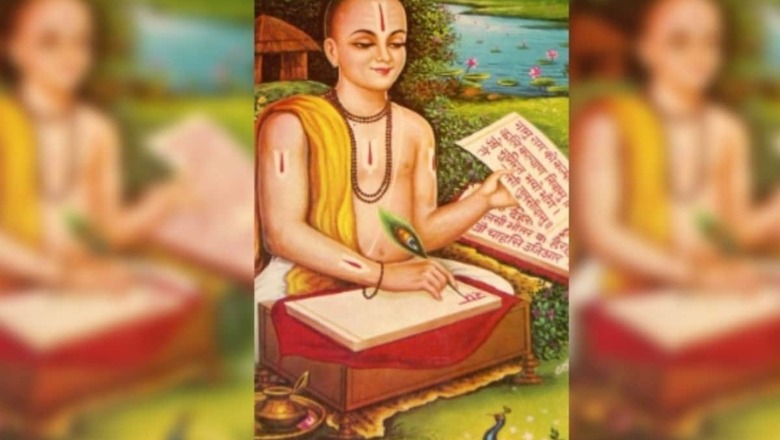
views
The onus of the survival and flourishing of a civilization (culture) to sustain itself while upholding the values against the onslaughts of time and invasions often falls on the guiding lights of the society that include poets, historians, writers and spiritual leaders.
The importance of saints, philosophers and intellectuals in shaping the minds and social conduct of people was realised quite early in India. Our contemporary literature became the artistic medium of passing on the values to younger generation.
Goswami Tulsidas was one such iconic figure who was a Ramanandi Vaishnava saint and poet, with immense spiritual, intellectual and academic learning. His childhood was spent in Kashi at Swami Ramananda’s ashram where his early education took place. He studied Vedas and Puranas and became a great scholar of Sanskrit.
Tulsidas, instead of writing Ramayana in Sanskrit as it used to be norm, wrote it in Awadhi — a language of the masses at that time. His aim was to make a bridge between Lord Rama’s life and common people. He wanted to make Ramcharitmanas a medium of folk renaissance through idolising high moral values or virtues.
The use of local language helped people in not only reading or memorising it, but also in having discourses on it. It soon reached every home and became an instrument against oppression. The ‘Chaupais’ of Ramcharitmanas gave hope and courage to the hapless Hindus who were facing the onslaught of Islamic invasions and rulers.
During his extensive travelling in north India, Tulsidas inspired youths to focus on physical fitness. Many traditional akharas were setup by him where there was no caste discrimination. He was also instrumental in the building of many Hanuman temples in north India. He founded the Sankatmochan Temple dedicated to Lord Hanuman in Varanasi.
It was ingenuousness of folk dialect of ‘Hanuman Chalisa’ (a long prayer offered to Lord Hanumana) which not only made it so popular among people, but it also made Lord Hanumana revered by all, irrespective of caste or creed.
Tulsidas started the Ramleela plays, a folk-theatre adaption of the Ram Charitmanas in Kashi (now Varanasi). The actors playing the characters of Ramayana used to memorise couplets from Tulsidas’s Ramacharitmanas.
Tulsidas took upon himself the extensive responsibility of training troups for Ramleela and used to send them to different places. This led to staging of Ramleela all over India. Through the characters and sequences depiction of ‘Ramcharitmanas’ he was successful in instilling bravery, valour, self-confidence and positivity in society. It was a solace for Hindus in cheering for Lord Rama’s victory over evil Ravana. This instilled confidence in them to resist the suppression of Islamic rulers.
Lord Rama’s ideal life and deeds acted as catalyst to strive for an ideal society. The discourse between Lord Rama and Shabari and Kevat was a message on social equanimity, a society without discrimination. In the eyes of Rama, only love and devotion matters and caste does not.
His rejection for caste-based society can be seen at several places in Ramcharitmanas I. According to Goswami Tulsidas, there were only two castes —one of the oppressor and the other of the one being oppressed.
His description of a time when Lord Rama built a Shiva temple in Rameshwaram helped to strengthen the bond of unity between two major Hindu sects — Shaivites and Vaishnavites.
Tulsidas has made an immense contribution in the strengthening of family values imbibing dignity and honour through Lord Rama’s life of purity, simplicity and self-sacrifice.
In Rama’s renunciation, Tulsidas set the template of how to be spiritually aligned while carrying on the duties of the world. Ramcharitmanas’s reach to the common people created a model for a perfect family unit with high moral values. People started imbibing those values in their living and continue to get inspired by it till day.
Out of the fear people were getting more inclined towards monarchy than devotion. Hindus were becoming fearful as there was coercion, persecution and they had to bear the burden of additional taxes. But all this did not stop Tulsidas from chanting Ramcharitmanas about his divine Rama.
The Mughal ruler Akbar used to invite distinguish scholar intellectuals to Agra to bestow upon them a rank or position. He sent Raja Todarmal with an invitation for Tulsidas, but Tulsidas spurned the offer as, for him, connecting people to divinity was more important than connecting them to a dynasty.
According to him the court of divine was much above the court of any rule on Earth. He sent his response to Akbar in the form of a couplet that meant, “We are the servants of lord Rama and we have signed a deed of serving rule of divine only. So how can we serve anyone else rule on this earth.”
Tulsidas wrote on devotional and social themes as well. His sensitivity on social issues is also seen in his writings where he focused on the plight of people affected by floods, drought and cruel administration of the Mughal rule.
Tulsidas was not only a saint or philosopher but also a great reformer. It was the solemn beauty and strength of his writings in Ramcharitmanas , Hanuman Chalisa, Ramkatha and Ramleelas that made him the saviour of society.
In his book, ‘Akbar: the great Mughal’, famous historian Vincent A. Smith writes about Tulsidas: “Tulsidas is the tallest tree in the magic garden of medieval Hindu poetry. His name will not be found in Ain-E-Akbari, or in the pages of Muslim analysts, or in the books of European authors based on the narratives of the Persian historians. Yet that (Hindu) was the greatest man of his age in India greater even than Akbar himself in as much as the conquest of the hearts and minds of millions of men and women affected by the poet was an achievement infinitely more lasting and important than all the victories gained in war by the Monarch.”
The author is Senior Fellow with Vichar Vinimay Kendra and has a co-authored a book ‘Ramjanambhoomi: Truth, Evidence and Faith’. Views expressed are personal.



















Comments
0 comment